
John Deere was an American blacksmith and manufacturer who founded Deere & Company, one of the largest and leading agricultural and construction-equipment manufacturers in the world. Born in Rutland, Vermont, Deere moved to Illinois and invented the first commercially successful steel plow in 1837.
Newport is a village in Herkimer County, New York, United States. The population was 640 at the 2010 census.

Linus Yale Jr. was a mechanical engineer, manufacturer, and co-founder with millionaire Henry R. Towne of the Yale Lock Company, which became the premier manufacturer of locks in the United States. He was the country's leading expert on bank locks and its most important maker. By the early 20th century, about three-quarter of all banks in America used his bank locks. He is best remembered for his inventions of locks, especially the cylinder lock, and his basic lock design is still widely distributed today, and constitutes a majority of personal locks and safes.
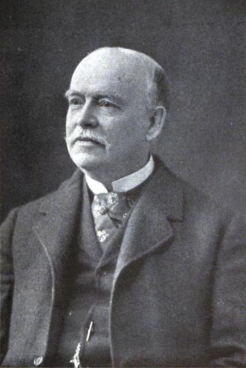
Josiah Cleaveland Cady or J. Cleaveland Cady, was an American architect known for his designs in Romanesque and Rundbogenstil styles. He was also a founder of the American Institute of Architects.
Yale & Valor was a company in Birmingham that manufactured locks and gas fires. It was listed on the London Stock Exchange.
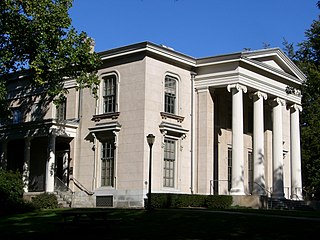
Hillhouse Avenue is a street in New Haven, Connecticut, famous for its many nineteenth century mansions, including the president's house at Yale University. Both Charles Dickens and Mark Twain have described it as "the most beautiful street in America." Much of the avenue is included in the Hillhouse Avenue Historic District, which extends to include houses on adjacent streets.

Linus Yale was an American inventor, manufacturer of bank locks, and 1st Mayor of Newport, New York. His patents were signed by President Andrew Jackson. His son, Linus Yale Jr., would later found the Premier manufacturer of locks in the United States, and be a pioneer in the American lock industry through the Yale Lock Company.

The South End of Stamford, Connecticut is a neighborhood located at the southern end of the city, just south of the Downtown neighborhood. The South End is a peninsula bordered by Downtown Stamford and Interstate 95 to the north and almost totally by water on all other sides, with few streets linking it to other neighborhoods.

Moses Yale Beach was an American inventor, entrepreneur, philanthropist and publisher, who started the Associated Press, and is credited with originating print syndication. His fortune, as of 1846, amounted to $300,000, which was about 1/4 of the fortune of Cornelius Vanderbilt at the time, and was featured in a book that he published named the Wealthy citizens of the City of New York. His newspaper, the New York Sun, became the most successful newspaper in America, and was a pioneer on crime reporting and human-interest stories for the masses.

The John B. Tytus House is a historic house at 300 South Main Street in Middletown, Ohio, United States. Built in 1865,it was the home of John Butler Tytus (1875-1944), who invented a practical hot wide-strip continuous steel-rolling process that transformed the American steelmaking industry. The house was designated a National Historic Landmark in 1976 due to the efforts of Jeri and Pat Rossi, who bought the house in 1970. The house was the residence of the Rossi family until 2011.
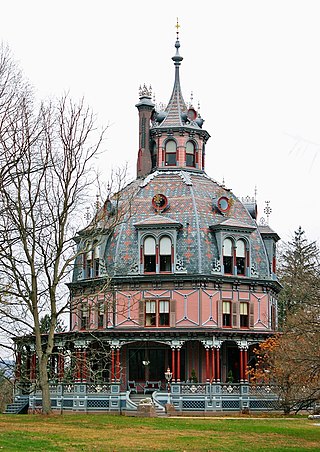
The Armour–Stiner House is an octagon-shaped and domed Victorian-style house located at 45 West Clinton Avenue in Irvington, in Westchester County, New York. It was designated a National Historic Landmark in 1976. It is the only known fully domed octagonal residence. The house was modeled after Donato Bramante’s 1502 Tempietto in Rome, which in turn was based on a Tholos, a type of ancient classical temple.

Marsh Hall, historically known as the Othniel C. Marsh House, is a historic house on Prospect Hill in New Haven, Connecticut. The property, which includes the house and a 6.8 acres (2.8 ha) grounds now known as Marsh Botanical Garden, was declared a National Historic Landmark in 1965. It was built in 1878 as the home of Othniel Marsh (1831–99), a leading 19th-century paleontologist, who occupied it until his death. The house is now owned by Yale University, and the building is occupied by the Yale School of the Environment.

Yale is one of the world's oldest lock manufacturers, owned by its parent company, Assa Abloy. Over its extensive history, Yale has received patents for dozens of its products, and the company has distributed its products to more than 120 countries, including Australia, Greece, India, Kuwait, and others. Yale's headquarters are located in Stockholm, Sweden.
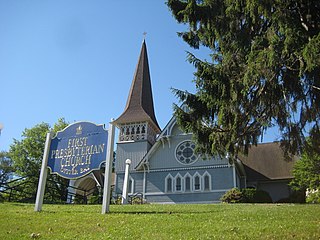
First Presbyterian Church built in 1873 is classified as an historic Stick/Eastlake style Presbyterian Church building located at 60 East Main Street in Oyster Bay, in the U.S. state of New York. Its architect was J. Cleaveland Cady, who was just beginning his career and would go on to design the original Metropolitan Opera House, the American Museum of Natural History, buildings at Yale University, Trinity College, and 23 other churches including the Plantsville Congregational Church, Southington, CT in the similar Gothic Revival style.

Watkins Mill in Lawson, Missouri, United States, is a preserved woolen mill dating to the mid-19th century. The mill is protected as Watkins Woolen Mill State Historic Site, which preserve its machinery and business records in addition to the building itself. It was designated a National Historic Landmark and added to the National Register of Historic Places in 1966 in recognition for its remarkable state of preservation. The historic site is the centerpiece of Watkins Mill State Park, which is managed by the Missouri Department of Natural Resources.
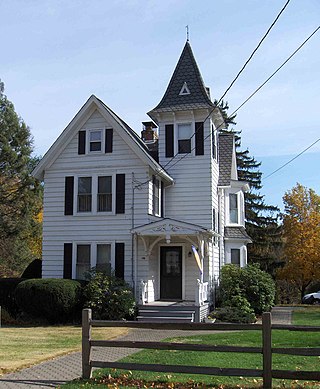
Marion is a neighborhood in the town of Southington, Connecticut. It is generally the area in the vicinity of the intersection of Route 322 and Marion Avenue just north of the Cheshire town line.

The Northville Historic District is located in Northville, Michigan. It was designated a Michigan State Historic Site in 1970 and listed on the National Register of Historic Places in 1972. The district is roughly bounded by Cady Street, Rogers Street, and Randolph Street; alterations to the boundaries of the city-designated district in 2003 and 2007 included structures on the opposite sides of the original bounding streets within the district. The district is located in the heart of old Northville, and is primarily residential, although the 73 contributing structures, include several commercial buildings and a church. The majority of the district contains Gothic Revival houses constructed between 1860 and 1880.

The Frederick P. Currier House is a private residential structure located at 231 East Saint Clair Street in the village of Almont in Almont Township in southeastern Lapeer County, Michigan. It was designated as a Michigan State Historic Site on April 5, 1975, and soon after added to the National Register of Historic Places on July 10, 1975.
Stuart Perry and William Swezey Houses, are two historic homes located at Newport in Herkimer County, New York. They were built in the late 1840s to plans by Alexander Jackson Davis. They are largely identical Italian Villa style, asymmetrical plan, masonry dwellings. They consist of a hipped roof block, centrally placed tower, and gable ended block.




















